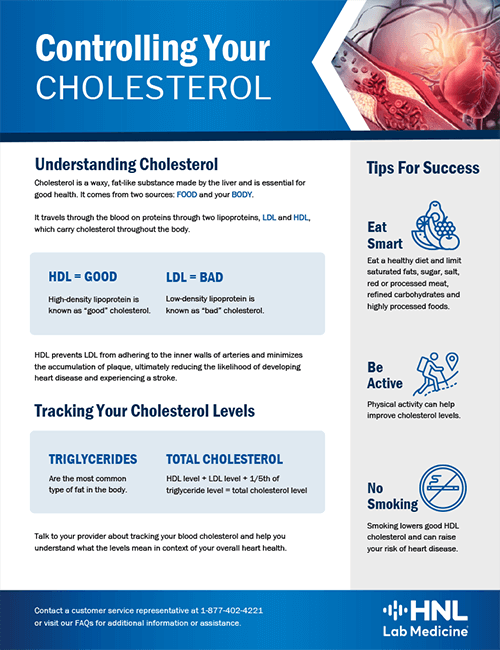The Basics of Cholesterol: Understanding its Role in Your Health
Almost 2 in 5 adults have high cholesterol, which puts them at risk for serious health conditions like heart disease and stroke¹. The only way to know whether you have high cholesterol is to get your cholesterol checked.
This is as easy as a simple blood test, called a lipid profile, to measure your cholesterol levels. Let’s learn more about cholesterol, and why screening for high cholesterol levels is important.
Cholesterol: What You Need to Know
Blood cholesterol is a waxy, fat-like substance made by the liver and is essential for good health. Cholesterol travels through the blood on proteins called lipoproteins. Two types of lipoproteins carry cholesterol throughout the body:
LDL (low-density lipoprotein) cholesterol, sometimes called “bad” cholesterol, makes up most of your body’s cholesterol. High levels of LDL cholesterol raise your risk for heart disease and stroke.HDL (high-density lipoprotein) cholesterol, sometimes called “good” cholesterol, absorbs cholesterol in the blood and carries it back to the liver. The liver then flushes it from the body. High levels of HDL cholesterol can lower your risk for heart disease and stroke. When your body has too much LDL cholesterol, the LDL cholesterol can build up on the walls of your blood vessels. This buildup is called plaque and it can cause health problems, such as heart disease and stroke.
Triglycerides are a type of fat in your blood that your body uses for energy. The combination of high levels of triglycerides with low HDL and/or high LDL cholesterol levels can increase your risk for health problems, such as heart attack.

High Cholesterol: Exploring the Causes
Certain health conditions increase your risk for high cholesterol, such as type 2 diabetes, because they decrease HDL (or “good”) cholesterol levels and raise LDL (or “bad”) cholesterol levels. This combination raises your risk of heart disease and stroke.
Obesity is linked to higher triglyceride levels, higher LDL cholesterol levels, and lower HDL cholesterol levels. Obesity can also lead to heart disease, high blood pressure, and diabetes. Other health conditions, such as familial hypercholesterolemia, can cause very high LDL cholesterol levels, too.
Symptoms and Testing
High cholesterol has no signs or symptoms, so the only way to know whether you have it is to get your cholesterol checked. Occasionally, some people develop yellowish growths on their skin called xanthomas, which are cholesterol-rich deposits. People with xanthomas may have high cholesterol levels.
Talk with your healthcare provider about your health history and how often you need to have your cholesterol checked. Cholesterol should be checked starting early in life- even children and adolescents should have their cholesterol checked.

Most healthy adults should have their cholesterol checked every 4 to 6 years ². Some people, such as people who have heart disease, diabetes, or a family history of high cholesterol, need to get their cholesterol checked more often.
Children and adolescents should have their cholesterol checked at least once between ages 9 and 11 and again between ages 17 and 21 ². Children who have obesity or diabetes may need to be screened for high cholesterol more often.
The Centers for Disease Control and Prevention recommends the following cholesterol levels for optimal health:
|
Optimal Cholesterol Levels³ |
|
|
Total cholesterol |
About 150 mg/dL |
|
LDL (“bad”) cholesterol |
About 100 mg/dL |
|
HDL (“good”) cholesterol |
At least 40 mg/dL in men and 50 mg/dL in women |
|
Triglycerides |
Less than 150 mg/dL |
 For more information
For more information
No matter your age, you can take steps each day to keep your cholesterol levels in a healthy range. Regular cholesterol screening can help prevent or manage high cholesterol because it enables healthcare providers to monitor changes in cholesterol levels over time.
If elevated cholesterol levels are detected, lifestyle modifications or medication to lower cholesterol can reduce the risk of heart disease. Making healthy food choices, exercising, quitting smoking, and limiting alcohol can all help prevent and manage high cholesterol.
For more information about cholesterol or making healthier lifestyle choices, visit the CDC’s website.
REFERENCES
¹ Centers for Disease Control and Prevention. (2023, September 06). Cholesterol. U.S. Department of Health and Human Services. https://www.cdc.gov/cholesterol/index.htm.
² Centers for Disease Control and Prevention. (2023, May 16). LDL and HDL cholesterol and triglycerides. U.S. Department of Health and Human Services. https://www.cdc.gov/cholesterol/ldl_hdl.htm.
³ Centers for Disease Control and Prevention. (2023, March 20). About cholesterol. U.S. Department of Health and Human Services. https://www.cdc.gov/cholesterol/about.htm#optimal.
⁴ Centers for Disease Control and Prevention. (2023, May 15). Get a cholesterol test. U.S. Department of Health and Human Services. https://www.cdc.gov/cholesterol/cholesterol_screening.htm.